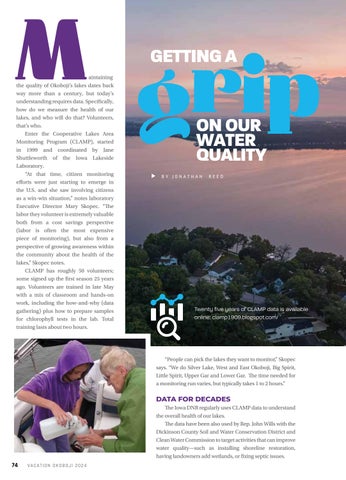GETTING A aintaining the quality of Okoboji’s lakes dates back way more than a century, but today’s understanding requires data. Specifically, how do we measure the health of our lakes, and who will do that? Volunteers, that’s who. Enter the Cooperative Lakes Area Monitoring Program (CLAMP), started in 1999 and coordinated by Jane Shuttleworth of the Iowa Lakeside Laboratory. “At that time, citizen monitoring efforts were just starting to emerge in the U.S. and she saw involving citizens as a win-win situation,” notes laboratory Executive Director Mary Skopec. “The labor they volunteer is extremely valuable both from a cost savings perspective (labor is often the most expensive piece of monitoring), but also from a perspective of growing awareness within the community about the health of the lakes,” Skopec notes. CLAMP has roughly 50 volunteers; some signed up the first season 25 years ago. Volunteers are trained in late May with a mix of classroom and hands-on work, including the how-and-why (data gathering) plus how to prepare samples for chlorophyll tests in the lab. Total training lasts about two hours.
ON OUR WATER QUALITY BY JONATHAN
REED
Twenty five years of CLAMP data is available online: clamp1909.blogspot.com/
“People can pick the lakes they want to monitor,” Skopec says. “We do Silver Lake, West and East Okoboji, Big Spirit, Little Spirit, Upper Gar and Lower Gar. The time needed for a monitoring run varies, but typically takes 1 to 2 hours.”
DATA FOR DECADES The Iowa DNR regularly uses CLAMP data to understand the overall health of our lakes. The data have been also used by Rep. John Wills with the Dickinson County Soil and Water Conservation District and Clean Water Commission to target activities that can improve water quality—such as installing shoreline restoration, having landowners add wetlands, or fixing septic issues.
74
VACATION OKOB OJI 2 0 2 4






